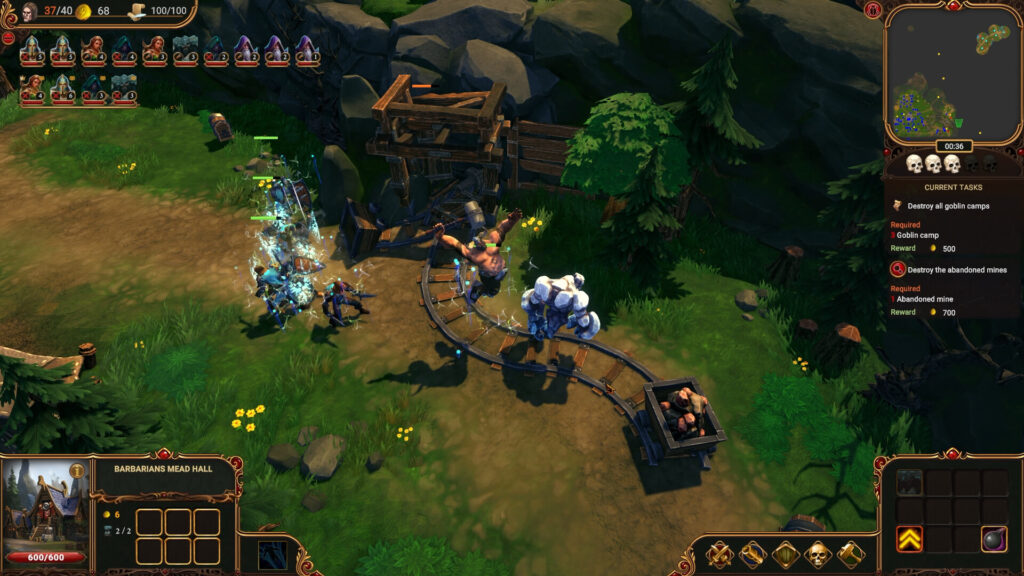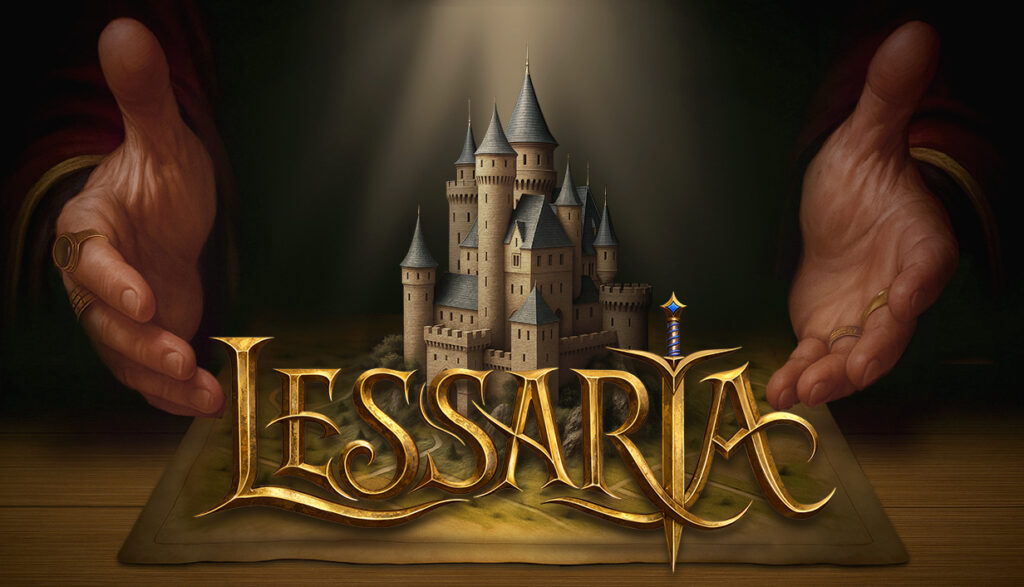For 25 years, a certain type of strategy gamer has been chasing a ghost. We are the fans of 1999’s Majesty: The Fantasy Kingdom Sim—a game that did the unthinkable. It put you on the throne and then told you, “You’re not in charge.” You couldn’t click a hero and send them to fight. You had to ask. You had to beg, bribe, and pray that your greedy, cowardly, and impossibly stupid heroes would stop drinking at the tavern long enough to save the kingdom.
It was chaotic, charming, and utterly brilliant. Its sequel, Majesty 2, modernized the formula but lost some of the charm. And since then… nothing. A grueling 16-year silence.
Now, Rockbee Team and Polden Publishing have stepped into that void with Lessaria: Fantasy Kingdom Sim. It calls itself the spiritual successor. It has the same core mechanic. It even has the voice of the original advisor, the inimitable George Ledoux, welcoming you back to the throne.
But after sinking hours into its campaign, a sinking feeling emerged. Lessaria has captured the form of Majesty, but it has almost completely missed the spirit.
The Crown is Familiar
On paper, Lessaria is exactly what fans have been asking for. You are a king with indirect control. You build a magical kingdom on a grid, place guilds to hire heroes—Rangers, Warriors, Rogues, etc.—and then watch them live their own lives. They wander, explore, buy equipment, and generally do whatever they please.
To get anything done, you must use bounty flags. Like in Majesty 2, you can place flags to Attack, Explore, Defend, or Avoid. Lessaria makes a welcome improvement here: the system is transparent, immediately telling you which heroes find your paltry 100-gold offer enticing and which ones are holding out for more. No more guessing.
It also introduces some smart, modern quality-of-life features. A portal system allows you to build a hub in your town and link it to pre-set locations on the map, solving the “my hero is 10 minutes away from the fight” problem. A “Squad” system lets you group heroes, which is a fantastic idea. It looks clean, it runs well, and it feels like the Majesty you remember… for about 30 minutes.

A Kingdom in a Shoebox
The first crack in the facade is the world itself. Where Majesty gave you sprawling maps to conquer, Lessaria feels claustrophobic. You build on a visible grid, which is fine, but your entire kingdom is limited to a relatively small, pre-defined circle around your castle. You can never expand beyond this border, save for placing a few Trading Posts on specific, pre-set locations.
This design choice fundamentally limits your sense of scale. You can’t build grand, sprawling cities. You can’t strategically place defensive towers deep in the wilderness to create a safe passage for your heroes. You are, and always will be, stuck in your starting box.
This is compounded by a new “population” resource. You must manually build peasant homes to increase your population, which is then “spent” on heroes and economic buildings. Hit a certain threshold, and your overall gold income is reduced. The game actively punishes you for growing too large, ensuring you’ll never have more than a couple of dozen heroes or a truly impressive-looking kingdom.
The Tyranny of the Timer
The single greatest deviation from the Majesty formula—and the game’s most baffling design choice—is the monster wave system. On a set timer, a wave of monsters will spawn and attack your kingdom. These waves have a strength rating from 1 to 5.
Here’s the problem: The only way to reduce the strength of the next wave is to destroy a monster den on the map. But the dens are finite, and the waves are infinite.
This creates a bizarre, counterintuitive, and deeply stressful gameplay loop. If your heroes are too good at their jobs and clear the map of lairs too quickly, you will have no way to mitigate the wave strength. You will soon be facing “Strength 5” assaults that will wipe your kingdom off the map. This system punishes you for playing well.
It effectively imposes a hard timer on every single mission, forcing you to preserve monster lairs. You’ll find yourself canceling “Attack” flags, praying your heroes don’t accidentally destroy the last den you were saving. It completely shatters the relaxing, sandbox-style build-up that was the hallmark of the original series.

A Kingdom Without a Voice
The mechanics are a mixed bag, but the game’s mortal sin is its complete lack of personality. The soul of Majesty was in its sound. It was a cacophony of life. You knew what was happening, even off-screen, because you could hear it.
You heard the jaunty cry of the “TAX COLLECTOR!” and knew your coffers were filling. You heard a blacksmith’s hammer and knew a hero was getting an upgrade. You heard a warrior scream “FOR THE KING!” as he charged, a rogue’s “I join… the wild spirits” as she died, or a cleric’s desperate “I’m mellllllltinnnnnng!”
Lessaria is silent.
Heroes have almost no audio quips. Death happens so quietly, you often don’t notice a hero is gone until you click their guild and see an empty slot. There is no mapping, no final cry. Buildings have no life; heroes just walk in and out, with no special animations or sounds at the tavern or market. Even the advisor, despite being voiced by the legendary George Ledoux, is given stilted, awkward lines like “upgrade of the building is complete.”
All those tiny, humorous, and irreplaceable details that made Majesty‘s world feel alive are gone. Lessaria is a kingdom of systems, not people. It’s a city of ghosts.
The Missing Sandbox
The final, unforgivable betrayal is the store page. As of this review, it proudly advertises a “sandbox mode.” For many Majesty fans, this was 90% of the game. It’s where you spent hundreds of hours, building the perfect kingdom.
It does not exist.
What Lessaria has is a single “endless survival mode” set on one static map, and it’s gated behind a separate “Supporter Pack” DLC. This is a baffling and frankly dishonest decision. The one feature that guarantees longevity and replayability, the absolute core of the Majesty experience, is completely absent.
A Welcome, Soulless Return
Is Lessaria a bad game? No. It’s a functional, modern, indirect-control RTS, a genre so starved for anything that this game’s mere existence is a blessing. For its $20-$25 price, it offers a solid 15-hour campaign and scratches an itch that has been festering for over a decade.
But is it the successor to Majesty? No. It’s a “fan-made remake of Majesty 2,” as one player aptly put it. It’s a game that copies the mechanics but misses the magic. It lacks the charm, the humor, the personality, and the sandbox freedom that made the original a timeless classic.
The developers are actively listening, patching bugs, and have promised free DLC, which is commendable. But it will take more than patches to give this kingdom a soul. If you are a die-hard fan of the genre, you should buy it—if only to show the world that we still exist. But temper your expectations. You are not returning home; you are visiting a well-made replica.
Pros:
- A true, modern successor to the Majesty indirect-control formula.
- Transparent bounty system and smart portal mechanic are great QoL additions.
- Features the legendary voice of advisor George Ledoux.
- Incredible value for the price in a completely underserved genre.
Cons:
- The design completely lacks the “spirit” and charm of the original; heroes and buildings are lifeless.
- The store page’s “sandbox mode” promise is false; a single survival map is gated behind DLC.
- The timed monster wave system is stressful and counterintuitive.
- Limited building space and population caps, due to claustrophobia, prevent grand-scale kingdoms.
- Lacks polish (typos, bad audio mixing, poor hero death feedback).
Lessaria: Fantasy Kingdom Sim: Lessaria: Fantasy Kingdom Sim is a game I desperately wanted to love, but I only ended up liking. It fills a 16-year-old void, but it does so with a competent, hollow shell. It’s the Majesty you remember, but with the volume turned all the way down. – Obsidian


